 Last additions - Omi-Hachiman 近江八幡市 Last additions - Omi-Hachiman 近江八幡市 |
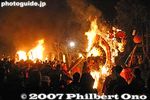
Three floats ablaze. 奉火Jul 14, 2009
|
|
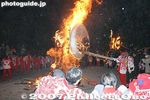
The remaining floats are set alight one after another until 10:40 pm.Jul 14, 2009
|
|

Jul 14, 2009
|
|

Straw all over the ground.Jul 14, 2009
|
|
|
|

Jul 14, 2009
|
|

Jul 14, 2009
|
|

Jul 14, 2009
|
|

The children's float returns to the shrine.Jul 14, 2009
|
|

Jul 14, 2009
|
|

Another "kenka" (fight) starts. けんかJul 14, 2009
|
|
|

At 8 pm, five floats are set on fire at one time by a torch such as this one.Jul 14, 2009
|
|

The front of the torii is a good viewing spot.Jul 14, 2009
|
|

Each float is pushed until they clash.Jul 14, 2009
|
|

Lost geta clog. The confetti is from the Dai-ikku float with the sakura theme. Supposed to be cherry blossom petals.Jul 14, 2009
|
|
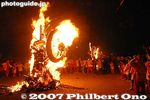
At this stage, the fire is quite hot. Sagicho Matsuri, Omi-HachimanJul 14, 2009
|
|
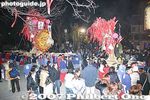
More floats return to the shrine to be burned.Jul 14, 2009
|
|
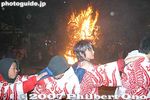
Running around the fire while chanting.Jul 14, 2009
|
|

Jul 14, 2009
|
|

They keep pushing until one of them topples over.Jul 14, 2009
|
|

Jul 14, 2009
|
|

Jul 14, 2009
|
|

WinnerJul 14, 2009
|
|

Jul 14, 2009
|
|

First, sake is sprinkled over the float.Jul 14, 2009
|
|
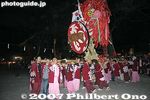
Later, the other floats return to the shrine by 8 pm.Jul 14, 2009
|
|

Push!Jul 14, 2009
|
|

Then they usually spin around until one float topples over.Jul 14, 2009
|
|

Near 5 pm, the floats start to leave the shrine and head back home.Jul 14, 2009
|
|

Jul 14, 2009
|
|

Jul 14, 2009
|
|

Jul 14, 2009
|
|
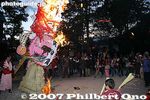
Jul 14, 2009
|
|
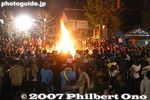
The crowd is drawn to the fire for warmth. It was a cold, windy day.Jul 14, 2009
|
|

Jul 14, 2009
|
|

WinnerJul 14, 2009
|
|

Jul 14, 2009
|
|

Beware of flying sparks and the wind which can blow the flames toward you. Of course, the fire dept. with fire hoses were on hand just in case.Jul 14, 2009
|
|

Sign of defeat as this float badly lists to one side.Jul 14, 2009
|
|

At 6 pm, the Shinmachi-dori children's float is set afire.Jul 14, 2009
|
|
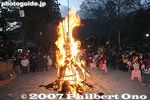
The kids then run around the fire while chanting "Masse-masse!"Jul 14, 2009
|
|

A real mish-mash.Jul 14, 2009
|
|

In the left corner is Jukku-kai... 十区会Jul 14, 2009
|
|

And in the right corner is Uwai-cho, ready to rumble. 魚屋町Jul 14, 2009
|
|

After a loud dragging noise, they clash and lock their antlers.Jul 14, 2009
|
|

Both sides push and push...Jul 14, 2009
|
|

The two children's floats separate.Jul 14, 2009
|
|

PeoniesJul 14, 2009
|
|

Jul 14, 2009
|
|

Children's float from Shinmachi-doriJul 14, 2009
|
|

Each float also has someone with wood clappers.Jul 14, 2009
|
|

This float won the top prize for float design. The banner reads "Yusho" (Champion). From Dai-juikku district. 第十一区Jul 14, 2009
|
|

Jul 14, 2009
|
|

If you missed it, there's always another float fight to watch.Jul 14, 2009
|
|

Here we go...Jul 14, 2009
|
|

Jul 14, 2009
|
|

Tapioca, chewing gum, rock salt, and dried cuttlefish are among the edible materials here.Jul 14, 2009
|
|

Uwai-cho float. 魚屋町のだしJul 14, 2009
|
|

Jul 14, 2009
|
|

Honmachi float leaving Himure Hachimangu Shrine. Sagicho Festival, Omi-Hachiman, Shiga. 本町のだしJul 14, 2009
|
|

Jul 14, 2009
|
|

Jul 14, 2009
|
|

On the first day (Sat.), the floats are paraded along the streets near the shrine and undergo judging for best design. The floats are works of art and made of edible materials mounted on a straw and wood base all to be set afire in the end.Jul 14, 2009
|
|

On the second day of the festival, the floats clash with each other. Sagicho floats pass through the torii of Himure Hachimangu Shrine, near Hachiman-bori Canal.Jul 14, 2009
|
|

Jul 14, 2009
|
|

Jul 14, 2009
|
|

Sagicho Matsuri, ShigaJul 14, 2009
|
|

This float won the top prize for float design.Jul 14, 2009
|
|

Float bearers push the end of the float to try and topple the other float. Each float clashes with various other floats during the afternoon on Sunday.Jul 14, 2009
|
|

Jul 14, 2009
|
|

On Sat., the first day of the two-day festival, there is a procession from 2 pm. It is led by these shrine officials and the shrine priest on horseback.Jul 14, 2009
|
|

Suwai-cho float. 仲屋町Jul 14, 2009
|
|

Gate of Himure Hachimangu Shrine which holds the Sagicho Festival. 日牟禮八幡宮Jul 14, 2009
|
|
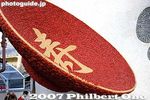
The sake cup has numerous little bead-like things. All edible.Jul 14, 2009
|
|

Shinmachi-dori Children's float passing through Shinmachi, Omi-Hachiman's old merchants quarters. 新町通りこどもJul 14, 2009
|
|

This clashing (or crashing) of floats is called "kenka" (fight). It lasts until 5 pm.Jul 14, 2009
|
|

Life-like boar, all edible materials.Jul 14, 2009
|
|
|

This float won 2nd place.Jul 14, 2009
|
|

Unlike the next day when the floats will clash with each other, here and within the shrine.Jul 14, 2009
|
|

Jul 14, 2009
|
|

Jul 14, 2009
|
|

Spectators in front of Hakuunkan watch the floats. Local police estimate 38,000 people came to see the festival this day.Jul 14, 2009
|
|

Another Shichikukai float, but for children.Jul 14, 2009
|
|

Floats go through the torii and head for Himure Hachimangu Shrine.Jul 14, 2009
|
|
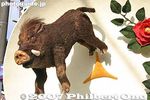
The yellow thing is made of corn.Jul 14, 2009
|
|

Jul 14, 2009
|
|

This design won 3rd place. White sugar is one of the ingredients.Jul 14, 2009
|
|

Jul 14, 2009
|
|

Dai-Juikku float. 第十一区Jul 14, 2009
|
|

Jul 14, 2009
|
|

Shichikukai float. 紫竹会のだしJul 14, 2009
|
|

Sagicho Matsuri, ShigaJul 14, 2009
|
|

Hanafuda playing cards.Jul 14, 2009
|
|

Introduction of all Sagicho floats: Fourteen floats from various districts of Omi-Hachiman then paraded through a circular route. This is the Dai-ikku float. 第一区Jul 14, 2009
|
|

They bond in friendship. These photos were taken on March 17-18, 2007, year of the boar. Jul 14, 2009
|
|

Small mushroomsJul 14, 2009
|
|

Ball made of candy.Jul 14, 2009
|
|

Jul 14, 2009
|
|
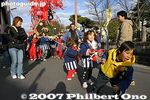
Dai-Juikku also has a small float for kids.Jul 14, 2009
|
|

Looks like ao-nori (seaweed powder).Jul 14, 2009
|
|

Looks like bread crust.Jul 14, 2009
|
|

Praying at the main hall of Himure Hachimangu Shrine. 日牟禮八幡宮Jul 14, 2009
|
|

This is a Takara-bune (Treasure Boat) design.Jul 14, 2009
|
|
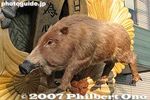
Jul 14, 2009
|
|

Children's floats go to battle.Jul 14, 2009
|
|

Ishin-cho float. 為心町のだしJul 14, 2009
|
|

Maid costumeJul 14, 2009
|
|

Looking for a rumble.Jul 14, 2009
|
|

Sanwakai float. 参和会Jul 14, 2009
|
|

Jul 14, 2009
|
|

It is said that even Nobunaga joined the festival and danced around in disguise. Hence, you can see people in costume or in disguise.Jul 14, 2009
|
|

They shout "Cho-yare!" or "Masse-masse!" It's related to food.「チョウヤレ」「マッセマッセ」Jul 14, 2009
|
|

Grounds of Himure Hachimangu Shrine which holds the Sagicho Matsuri. 日牟禮八幡宮Jul 14, 2009
|
|

Black rice, beans, and more.Jul 14, 2009
|
|

The following photos were taken on the second day of the festival. On the festival's 2nd day (Sun.), the floats are paraded from 10:30 am and arrive at the shrine by 2 pm.Jul 14, 2009
|
|

Ready to rumble.Jul 14, 2009
|
|

Deer seems to have some sort of candy shavings.Jul 14, 2009
|
|

Tiny fish form the pine tree design on the fans.Jul 14, 2009
|
|

Many homes hang red streamers during the Sagicho Festival.Jul 14, 2009
|
|

In front of the torii gate, two floats join up.Jul 14, 2009
|
|

Notice the Treasure Boat.Jul 14, 2009
|
|
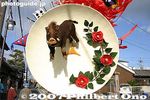
Peony dish design.Jul 14, 2009
|
|
|
|

Miyauchi-cho float. 宮内町のだしJul 14, 2009
|
|

Shrine officials followed by chigo children carrying red paper streamers.Jul 14, 2009
|
|

Jul 14, 2009
|
|

This has a chrysanthemum design which is the Imperial family crest. To celebrate the newborn prince.Jul 14, 2009
|
|
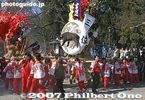
When Nobunaga was killed and the castle destroyed, people in Azuchi moved to Omi-Hachiman and restarted the festival here. This float won 3rd place, from Miyauchi-cho. 宮内町Jul 14, 2009
|
|

Ikeda-machi float. 池田町のだしJul 14, 2009
|
|

Folding fansJul 14, 2009
|
|

Boar and peony.Jul 14, 2009
|
|

Jul 14, 2009
|
|

Dai-niku float in front of Hakuunkan, a classic Western-style building, now a tourist info office and exhibition gallery. Also see the video at YouTube. Sagicho Festival, Omi-Hachiman. 第二区Jul 14, 2009
|
|

Shrine priest on horseback and behind him on another horse is the mayor of Omi-Hachiman who serves as the Honorary Chairman of the Sagicho Festival.Jul 14, 2009
|
|

Jul 14, 2009
|
|

Jukku-kai float. 十区会Jul 14, 2009
|
|

It has a cherry tree, a red sake cup, and boar. Sagicho floats depict animals from the Oriental Zodiac, and 2007 was the Year of the Boar.Jul 14, 2009
|
|

Omi-Hachiman's Sagicho Festival originated in neighboring Azuchi-cho town where Oda Nobunaga had his magnificent castle.Jul 14, 2009
|
|

Shinmachi-dori float. 新町通りのだしJul 14, 2009
|
|

Jul 14, 2009
|
|

Sea turtle and "tancho" crane are auspicious symbols.Jul 14, 2009
|
|

Shinmachi is where the Omi shonin merchants lived.Jul 14, 2009
|
|
|
|

Small silvery fish, beans, and perhaps onions. Looks like very painstaking work. Sagicho Festival, Omi-Hachiman, Shiga.Jul 14, 2009
|
|

Jul 14, 2009
|
|
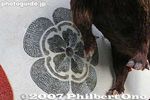
Numerous tiny fish heads make up this flower design.Jul 14, 2009
|
|

The float returns to the shrine.Jul 14, 2009
|
|

Sometimes a float collapses when float bearers get too tired.Jul 14, 2009
|
|

By 2 pm, the shrine grounds (actually a parking lot) is filled with floats and people.Jul 14, 2009
|
|

Jul 14, 2009
|
|

Jul 14, 2009
|
|

Ao-nori (powery seaweed) was used to make the dark-green leaves.Jul 14, 2009
|
|

Two floats clash.Jul 14, 2009
|
|

The boar's mane is made of tiny fish. You can smell the seafood. I'm surprised that crows never swooped down on the floats to feast on them.Jul 14, 2009
|
|

Jul 14, 2009
|
|

Float bearers make a circle and spin around while shouting "Cho-yare" or "Masse masse!"Jul 14, 2009
|
|

Held during the weekend in mid-March, the Sagicho Matsuri is a dramatic parade and clashing of 13 or 14 colorful Sagicho floats. On the first day at 1 pm, 14 Sagicho Festival floats gather at Himure Hachimangu Shrine near Hachiman-bori Canal.Jul 14, 2009
|
|

The place is packed with people. Normally, it is a parking lot. The shrine is a few minutes by bus from Omi-Hachiman Station. MAPJul 14, 2009
|
|

From 2 pm, the procession starts and the floats start to exit the shrine. Also see the video at YouTube.Jul 14, 2009
|
|

Group from Kyoto called Kawasemi, named after the kingfisher bird.Jul 10, 2009
|
|

Playing the yoshibue reed flute from Lake Biwa.Jul 10, 2009
|
|
|

Jul 10, 2009
|
|

The final number was Biwako Shuko no Uta (Lake Biwa Rowing Song).Jul 10, 2009
|
|

Hot Line often appears at various events. He plays the guitar while she plays the yoshibue. 「よし笛の日」定期演奏会Jul 10, 2009
|
|

Jul 10, 2009
|
|

The Japan Yoshibue Association held a yoshibue (flute made of reeds growing in Lake Biwa) concert on April 4, 2009 which was Yoshibue Day. Various groups playing the reed flute gathered to perform a free concert. This married pair called Hot Line. ほっ�Jul 10, 2009
|
|

Part of the stage decoration were these towering bundles of reeds from Lake Biwa.Jul 10, 2009
|
|

Jul 10, 2009
|
|

A duo called Lake Reed.Jul 10, 2009
|
|

Jul 10, 2009
|
|

Kikui-san 菊井 了Jul 10, 2009
|
|

Jul 10, 2009
|
|
|

Special halftime entertainment provided by a Uyghur dish dancer by a Chinese dancer. She is an graduate student attending Hyogo University. ジャミラ ウライムJul 10, 2009
|
|

Jul 10, 2009
|
|

Inside the Bungei Seminario in Azuchi, Shiga. This hall is noted for a large pipe organ. The yoshibue concert started at noon and ended at about 4 pm. Free admission.Jul 10, 2009
|
|

Jul 10, 2009
|
|
|
|

Yoshibue Junior Ensemble consisting of kids playing the reed flute. Eighteen yoshibue groups performed. Most of them welcome new members. I saw groups from Omi-Hachiman, Moriyama, Konan, Otsu, Yasu, and Kyoto.Jul 10, 2009
|
|

Sign says "Yoshibue Day" which is April 4. "Yoshi" means reed, and both yo and shi can also be translated as the number 4.Jul 10, 2009
|
|

Jul 10, 2009
|
|

Jul 10, 2009
|
|

The concert was held by the Japan Yoshibue Association (Nihon Yoshibue Kyokai 日本よし笛協会) formed in 2006. Jul 10, 2009
|
|

This is Mr. Kikui, the inventor of the yoshibue.Jul 10, 2009
|
|

Yoshibue reed flute, made from reeds growing in Lake Biwa (Lake Nishinoko).Jul 10, 2009
|
|

Yoshibue is a small flute made from reeds grown in Lake Nishinoko, one of Lake Biwa's attached lake. I attended the 4th Yoshibue Concert on April 4, 2009 which was Yoshibue Day. Jul 10, 2009
|
|

Azuchi has a cultural complex called Bungei no Sato. It includes a concert hall called Bungei Seminario, the venue of the Yoshibue Concert. If you missed the shuttle bus, you'll have to take a taxi from Azuchi Station. 文芸セミナリヨJul 10, 2009
|
|

Flower arrangement using reeds.Jul 10, 2009
|
|

Musa-juku was the sixty-sixth of the sixty-nine stations or shukuba post towns on the Nakasendo Road. It is the seventh Nakasendo station in Shiga (following Echigawa-juku in Aisho). MAPMusa was one of ten Nakasendo stations in Shiga. There is very little left. Near Ohmi Railways Musa Station, a short ride from Omi-Hachiman.Mar 23, 2007
|
|
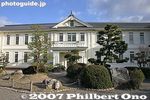
Hachiman Primary School 近江八幡市立八幡小学校Mar 21, 2007
|
|
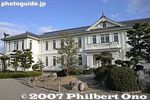
Hachiman Primary School 近江八幡市立八幡小学校Mar 21, 2007
|
|

In Omi-Hachiman, Shinmachi-dori looking toward Hachimanyama. This area is also a National Important Traditional Townscape Preservation District (重要伝統的建造物群保存地区).Mar 21, 2007
|
|

Mizugahama lakeside coffee shop 水ケ浜Jan 02, 2007
|
|

Jan 02, 2007
|
|

Jan 02, 2007
|
|

Misty Omi-Hachiman coastJan 02, 2007
|
|

Jan 02, 2007
|
|

Jan 02, 2007
|
|

Jan 02, 2007
|
|

Leaving Okinoshima (we'll be back).Jan 02, 2007
|
|

Jan 02, 2007
|
|

Jan 02, 2007
|
|

Narrow alleyJan 02, 2007
|
|

Okinoshima PortJan 02, 2007
|
|

Renmyo was here.Jan 02, 2007
|
|

Jan 02, 2007
|
|

Shore roadJan 02, 2007
|
|

Jan 02, 2007
|
|

Neck of Okishima.Jan 02, 2007
|
|

Steps to the larger hillJan 02, 2007
|
|

Okinoshima Port and boat scheduleJan 02, 2007
|
|

Jan 02, 2007
|
|

Sea wallJan 02, 2007
|
|

Okishima PortJan 02, 2007
|
|

Entering Okinoshima Port. Okishima is the largest island in Lake Biwa. MAPJan 02, 2007
|
|

Side of boatJan 02, 2007
|
|

Okinoshima PortJan 02, 2007
|
|

Jan 02, 2007
|
|

Jan 02, 2007
|
|

Misty OkinoshimaJan 02, 2007
|
|

Jan 02, 2007
|
|

Okinoshima in sightJan 02, 2007
|
|

Leaving Horikiri PortJan 02, 2007
|
|

Misty Omi-Hachiman coastJan 02, 2007
|
|

Jan 02, 2007
|
|

Jan 02, 2007
|
|

Boat for Okinoshima at Horikiri PortJan 02, 2007
|
|

Okishima (Okinoshima) is Lake Biwa's largest island inhabited by over 400 residents, mainly into fishing. Short boat ride away from Omi-Hachiman's Horikiri port. MAPJan 02, 2007
|
|

Misty Horikiri Port in Omi-Hachiman. Boats leave here for Okishima island, Lake Biwa's largest island.Jan 02, 2007
|
|

Fishing boats at Horikiri PortJan 02, 2007
|
|

Nishikawa residence.Dec 31, 2006
|
|

Nishikawa residence.Dec 31, 2006
|
|
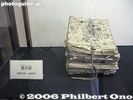
Business diaryDec 31, 2006
|
|
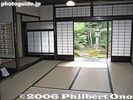
Nishikawa residence.Dec 31, 2006
|
|

Nishikawa residence.Dec 31, 2006
|
|
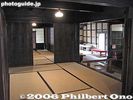
Nishikawa residence.Dec 31, 2006
|
|
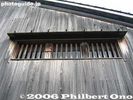
Wall of Nishikawa residence.Dec 31, 2006
|
|

Inside Nishikawa residence. Omi-Hachiman, Shiga. 国重要文化財畳表や蚊帳を扱っていた江戸時代の豪商・西川利右衛門の旧宅Dec 31, 2006
|
|
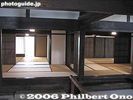
Nishikawa residence.Dec 31, 2006
|
|
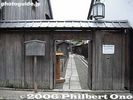
Entrance to Nishikawa Residence. During the Edo Period, the family made their fortune selling mosquito nets and tatami straw matting.Dec 31, 2006
|
|
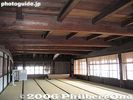
Inside former Ban family residence, 2nd floor.Dec 31, 2006
|
|
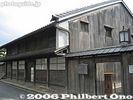
Former Nishikawa Residence (Kyu-Nishikawa-ke Jutaku), large Omi merchant home designated as an Imnportant Cultural Property. Omi-Hachiman, Shiga. 旧西川家住宅 国重要文化財Dec 31, 2006
|
|
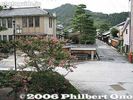
Dec 31, 2006
|
|
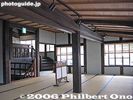
Inside former Ban family residence.Dec 31, 2006
|
|
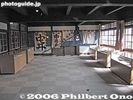
Inside former Ban family residence. They made their fortune selling mosquito nets and tatami straw matting.Dec 31, 2006
|
|
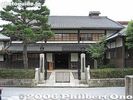
Former Ban family Omi merchant home which also served as a girls school and public library until 1997. Omi-Hachiman, Shiga. 旧伴家住宅Opened to the public in 2004 as a museum. 伴庄右衛門は江戸時代初期から活躍した八幡商人の一人で、屋号を扇屋といい、主に畳表・蚊帳を商い豪商となった。Dec 31, 2006
|
|
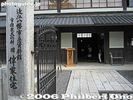
Entrance to former Ban family residence. Completed in 1840. 旧伴家住宅伴庄右衛門は江戸時代初期から活躍した八幡商人の一人で、屋号を扇屋といい、主に畳表・蚊帳を商い豪商となった。Dec 31, 2006
|
|
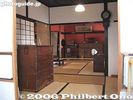
Omi merchant house, History and Folklore MuseumDec 31, 2006
|
|
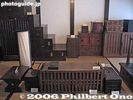
Omi merchant desk, History and Folklore Museum 近江商人の帳場風景Dec 31, 2006
|
|
| 1087 files on 5 page(s) |
 |
3 |  |
|